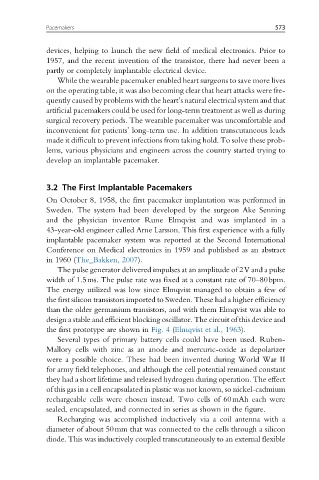Page 580 - Handbook of Biomechatronics
P. 580
Pacemakers 573
devices, helping to launch the new field of medical electronics. Prior to
1957, and the recent invention of the transistor, there had never been a
partly or completely implantable electrical device.
While the wearable pacemaker enabled heart surgeons to save more lives
on the operating table, it was also becoming clear that heart attacks were fre-
quently caused by problems with the heart’s natural electrical system and that
artificial pacemakers could be used for long-term treatment as well as during
surgical recovery periods. The wearable pacemaker was uncomfortable and
inconvenient for patients’ long-term use. In addition transcutaneous leads
made it difficult to prevent infections from taking hold. To solve these prob-
lems, various physicians and engineers across the country started trying to
develop an implantable pacemaker.
3.2 The First Implantable Pacemakers
On October 8, 1958, the first pacemaker implantation was performed in
Sweden. The system had been developed by the surgeon Ake Senning
and the physician inventor Rune Elmqvist and was implanted in a
43-year-old engineer called Arne Larsson. This first experience with a fully
implantable pacemaker system was reported at the Second International
Conference on Medical electronics in 1959 and published as an abstract
in 1960 (The_Bakken, 2007).
The pulse generator delivered impulses at an amplitude of 2V and a pulse
width of 1.5ms. The pulse rate was fixed at a constant rate of 70–80bpm.
The energy utilized was low since Elmqvist managed to obtain a few of
the first silicon transistors imported to Sweden. These had a higher efficiency
than the older germanium transistors, and with them Elmqvist was able to
design a stable and efficient blocking oscillator. The circuit of this device and
the first prototype are shown in Fig. 4 (Elmqvist et al., 1963).
Several types of primary battery cells could have been used. Ruben-
Mallory cells with zinc as an anode and mercuric-oxide as depolarizer
were a possible choice. These had been invented during World War II
for army field telephones, and although the cell potential remained constant
they had a short lifetime and released hydrogen during operation. The effect
of this gas in a cell encapsulated in plastic was not known, so nickel-cadmium
rechargeable cells were chosen instead. Two cells of 60mAh each were
sealed, encapsulated, and connected in series as shown in the figure.
Recharging was accomplished inductively via a coil antenna with a
diameter of about 50mm that was connected to the cells through a silicon
diode. This was inductively coupled transcutaneously to an external flexible

